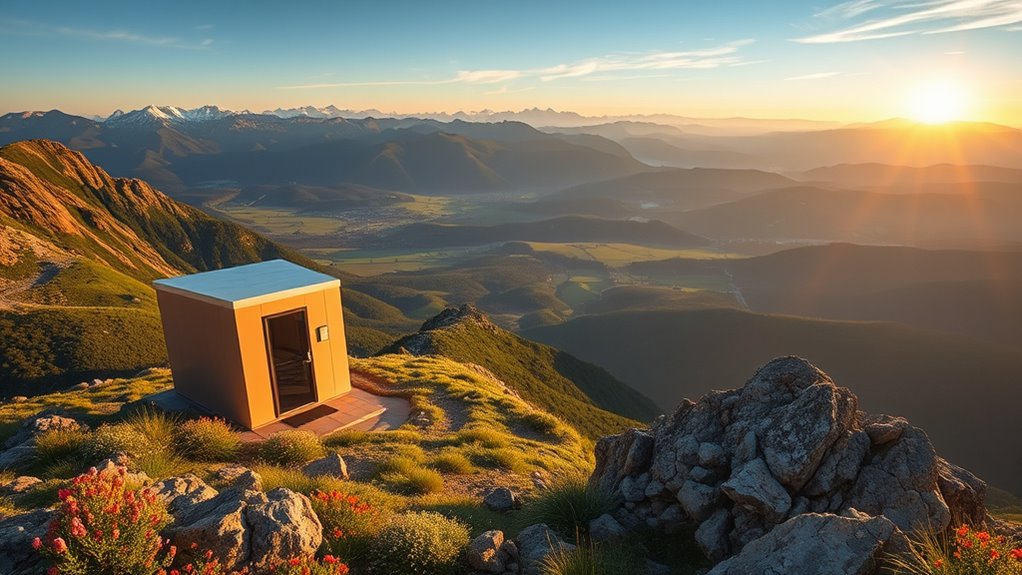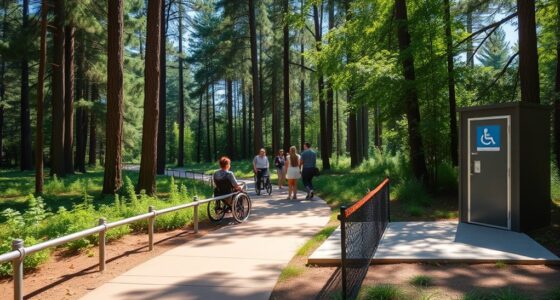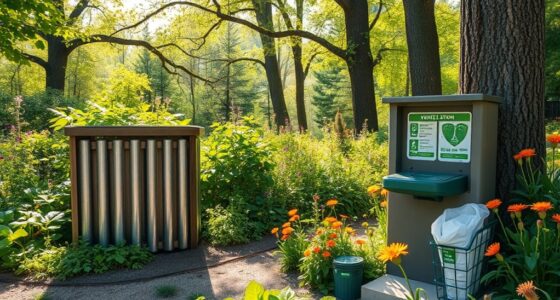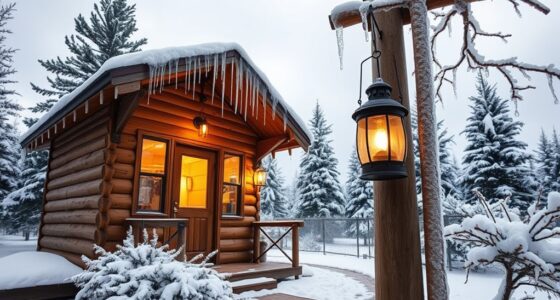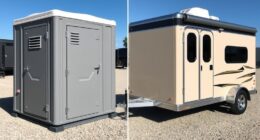To place restrooms without ruining the view, position them away from scenic vistas and high-traffic areas, using natural screening like trees and shrubs to blend them into the landscape. Use land contours and existing vegetation to hide facilities and control runoff. Place them centrally or near main paths for easy access, but keep them clear of active construction zones. For more tips on balancing functionality with scenery, keep exploring these strategies.
Key Takeaways
- Position restrooms behind natural screening elements like trees or shrubs to hide them without obstructing scenic views.
- Use natural land contours to locate facilities on lower or less visible slopes, preserving key vistas.
- Place restrooms centrally or near high-traffic zones to minimize visual impact on scenic areas.
- Design pathways that navigate around viewpoints, keeping restrooms out of direct sightlines.
- Ensure restrooms are integrated into landscape design to blend seamlessly, avoiding disruption to the natural aesthetic.
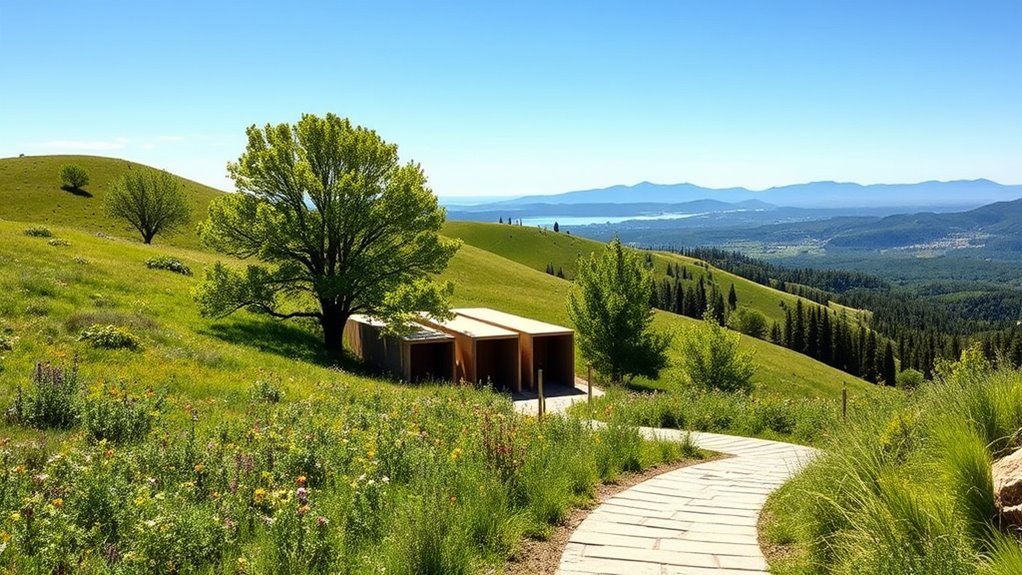
Have you ever wondered how a well-designed site layout can streamline construction and improve efficiency? When planning where to place restrooms on a construction site, thoughtful layout decisions can make a significant difference. One key aspect is landscape integration—ensuring the restroom locations blend seamlessly with the natural surroundings and the overall site design. By considering the landscape, you can prevent the restrooms from becoming eyesores or disrupting scenic views, maintaining the aesthetic appeal of the project. Proper landscape integration also involves choosing natural screening elements like trees or shrubs to shield the facilities, helping them blend into the environment without compromising the site’s visual harmony.
Integrate restrooms seamlessly with the landscape using natural screening and site design for visual harmony.
Accessibility considerations are equally essential when placing restrooms. You need to make sure they’re conveniently located for workers, visitors, and emergency services, without creating unnecessary detours or obstructions. Positioning restrooms centrally or near high-traffic areas ensures easy access, reducing time wasted walking across the site and increasing overall efficiency. Keep in mind that accessible routes should be free of obstacles, with smooth pathways that accommodate wheelchairs, carts, or other mobility aids. These considerations not only comply with safety standards but also foster an inclusive environment where everyone can move comfortably and efficiently around the site.
When integrating restrooms into your layout, think about the flow of construction activities. Avoid placing them in areas that may interfere with ongoing work or heavy machinery movement. For example, situating facilities away from active excavation zones or material storage prevents disruptions and keeps the site organized. Additionally, consider future expansion; leaving space around the restrooms can facilitate easy maintenance, cleaning, or upgrades without disturbing nearby work zones.
Another aspect to keep in mind is environmental impact. Restrooms should be located to minimize runoff into natural waterways or sensitive landscapes. Using natural land contours and existing vegetation can help direct drainage safely away from water sources. This planning not only preserves the environment but also prevents potential delays caused by environmental compliance issues. Incorporating site layout principles ensures that restroom placement supports both the project’s functional needs and environmental sustainability.
In essence, placing restrooms on a construction site isn’t just about convenience—it’s about strategic planning that balances landscape integration, accessibility considerations, safety, and environmental responsibility. When you approach site layout with these factors in mind, you’ll create a functional, harmonious environment that supports the project’s efficiency and aesthetic appeal. Thoughtful placement ensures that the facilities serve their purpose without detracting from the natural beauty or disrupting workflow, ultimately contributing to a successful construction process.
Frequently Asked Questions
How Can Natural Landscapes Be Preserved When Installing Restrooms?
You can preserve natural landscapes by integrating restrooms seamlessly into the environment, focusing on landscape integration. Use natural materials and colors that blend with the surroundings, maintaining aesthetic harmony. Position facilities discreetly, avoiding key views and delicate features. Opt for eco-friendly designs and consider underground or partially buried structures to minimize visual impact. This approach helps protect the landscape’s beauty while providing functional restroom facilities.
What Environmentally Friendly Options Exist for Restroom Construction?
Imagine your restroom as a green heartbeat on the landscape. You can choose eco-friendly materials like bamboo, recycled steel, or reclaimed wood to minimize impact. Incorporate renewable energy sources, such as solar panels or wind turbines, to power lights and ventilation sustainably. These options weave seamlessly into the environment, ensuring your facility blends gently with nature while reducing your ecological footprint, keeping the land vibrant and alive for generations to come.
How Do Local Regulations Influence Restroom Placement in Scenic Areas?
Local regulations, like zoning restrictions and permit requirements, greatly influence where you can place restrooms in scenic areas. You must guarantee your plans comply to avoid delays or fines. Check with local authorities early, understand setback rules, and secure necessary permits. This helps you position restrooms thoughtfully, preserving views while adhering to regulations, ensuring your project progresses smoothly without compromising the area’s natural beauty.
Are There Innovative Design Solutions to Minimize Restroom Visibility?
Did you know that 65% of visitors say restroom visibility impacts their scenic experience? To minimize visibility, you can use innovative design solutions like visual screening and architectural camouflage. Incorporate natural materials or greenery to blend restrooms seamlessly into the landscape. Smart placement and creative structures help hide facilities without disrupting the view, ensuring visitors enjoy the scenery while maintaining practical amenities.
How Can Visitor Flow Be Managed Around Restrooms Without Disrupting Views?
You can manage visitor flow around restrooms by strategically positioning pathways that guide circulation smoothly while integrating landscape features. Use natural barriers like plantings or slight elevation changes to subtly direct movement without blocking scenic views. Incorporate visual cues and signage to encourage visitors to follow designated routes, ensuring seamless landscape integration. This approach maintains the aesthetic appeal and preserves spectacular vistas while keeping circulation efficient and unobtrusive.
Conclusion
Think of your site like a delicate garden. Just as you’d hide a restroom behind a lush hedge, you can tuck it away without blocking the sunlit view. By carefully choosing its placement, you’re like an artist painting a seamless landscape—blending function with beauty. When you balance practicality and aesthetics, your outdoor space becomes a harmonious masterpiece, where every element, even restrooms, adds to the overall charm without stealing the spotlight.
